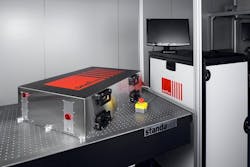Onefive collaborates with XFEL on all-optical-fiber front end for pump-probe experiments
Ultrafast laser manufacturer Onefive (Regensdorf, Switzerland) and the Laser Group of European XFEL (Hamburg, Germany), an X-ray free-electron laser that recently started commissioning, have successfully joined their expertise in the development and commissioning of an all-optical-fiber front end as part of a unique laser system for experiments at the new research facility.1
RELATED ARTICLE: European XFEL camera to image molecules at 4.5 million frames per second
The European XFEL is developing high-power burst-mode femtosecond pump-probe lasers to be used for experiments in combination with the facility’s X-ray beams. The ultrashort, high-intensity X-ray laser pulses available at the facility will enable studies of ultrafast processes in solids, gas-phase, chemical and biomolecular structures, and extreme states of matter down to the atomic level. Its pump-probe lasers will typically activate samples, followed by probing with the X-ray pulses.
These laser sources rely on very high-power and high-energy sub-picosecond pulses at 1 micron wavelength, arranged in low duty cycle burst patterns. At the heart of the European XFEL pump-probe laser design lies a fully optical fiber based front-end laser system. This new laser system, the Origami - 10 XP Dual Burst, is highly specialized and has been customized by Onefive to the unique requirements of the pump-probe laser.
Onefive brought in its expertise in low-noise ultrafast laser physics, advanced packaging, industrial-grade manufacturing and systematic testing to build this all-fiber laser system. This laser system is seeded with an ultralow-noise femtosecond laser at 1 micron with consecutive pulse picking and amplification. It provides dual output ports for multiple beamlines for simultaneously providing the seed and pump line for a noncollinear optical parametrical amplifier. It is bursted with flexible burst time and can provide burst-to-burst variable repetition rate while keeping other parameters constant. It can be completely remote controlled, is integrated in the European XFEL software environment and the laser head is entirely passively air-cooled for low vibration and excellent beam pointing stability.
Onefive lasers are designed and qualified for 24/7 operation under harsh environments.
REFERENCE
1. M. Pergament et al., Optics Express 24, 26, 29349-29359 (2016).
SOURCE: Onefive; http://www.onefive.com/uploads/onefive_pressrelease_15february2017.pdf

Gail Overton | Senior Editor (2004-2020)
Gail has more than 30 years of engineering, marketing, product management, and editorial experience in the photonics and optical communications industry. Before joining the staff at Laser Focus World in 2004, she held many product management and product marketing roles in the fiber-optics industry, most notably at Hughes (El Segundo, CA), GTE Labs (Waltham, MA), Corning (Corning, NY), Photon Kinetics (Beaverton, OR), and Newport Corporation (Irvine, CA). During her marketing career, Gail published articles in WDM Solutions and Sensors magazine and traveled internationally to conduct product and sales training. Gail received her BS degree in physics, with an emphasis in optics, from San Diego State University in San Diego, CA in May 1986.
